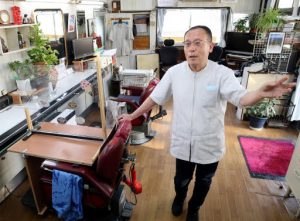- A-bomb Images
- Photographic negatives taken by Yoshito Matsushige designated as Hiroshima’s important cultural properties
Photographic negatives taken by Yoshito Matsushige designated as Hiroshima’s important cultural properties
by Kyosuke Mizukawa, Staff Writer
On March 26, the Hiroshima Municipal Board of Education designated five negatives of photographs taken on the day of the atomic bombing as the city’s important tangible cultural properties. The photos were taken by the late Yoshito Matsushige, former staff photographer for the Chugoku Shimbun. His family hopes the designation will contribute to creating better conditions for the preservation of the negatives and to their further utilization to convey the horrors of the atomic bombing to future generations.
After hearing the news that the photographic negatives had been designated important cultural properties, Motoki Oya, 79, Mr. Matsushige’s nephew, said “I’ve come to realize again how precious the photos are. I don’t remember the atomic bombing, but thanks to my uncle I can see how powerful the bomb’s blast was.” Mr. Oya, a barber, inherited the barbershop that Mr. Matsushige reproduced in a photo taken on the day of the atomic bombing. The building, located in Midori-machi (now Nishi Midori-machi, Minami Ward), also served as Mr. Matsushige’s home.
The barbershop was operated, together with others, by the late Hisayo Oya, Mr. Matsushige’s sister and Mr. Oya’s mother. The shop was about 2.7 kilometers to the southeast of the hypocenter. Mr. Matsushige’s photo of the barbershop, whose window frames had been blown away, also showed the collapsed building of a branch of a fire station through a window. Mr. Oya was three years old at the time. Two days after the atomic bombing, he returned from the location where he had been staying to avoid the risk of air raids and was exposed to residual radiation, although he has said he has no memory of that time.
The A-bombed building housing the barbershop still exists today, with the arrangement of the chairs in the shop nearly the same. He has shown the photo of the building to customers and told them about how things were at the time of the bombing. “I want my children and grandchildren to have a chance to look at this and the other photos,” he said.
“It is truly an honor. My father’s feelings and his sharing of testimonies seem as if they might be rewarded,” said Kayo Inoshita, 77, Mr. Matsushige’s daughter. A resident of the city of Miyoshi, Hiroshima Prefecture, she hopes the designation will lead to preservation and further utilization of the negatives.
After retiring from the Chugoku Shimbun, Mr. Matsushige communicated to others his experience of the atomic bombing until around the age of 90, all while suffering from kidney disease. After his mid-80s, he would give his testimony after undergoing kidney dialysis at a hospital. Ms. Inoshita said it broke her heart to see her father persist in exhibiting photos and telling his stories. “I didn’t want him to go, so I told him to not overwork himself. But he would say, ‘Even if I were laid up in bed as a result, I wouldn’t regret any of it.’”
Ms. Inoshita sees her gentle father’s emotional conflict in a photo of wounded people taken from behind them, not from their front, at Miyuki Bridge. “He must have hesitated to click the shutter with people in such misery. Still, he took the photo to fulfill his sense of mission in his work.” She added, “I hope all the photos can be fully utilized to convey the memories of the atomic bombing to young people.”
(Originally published on March 27, 2021)







